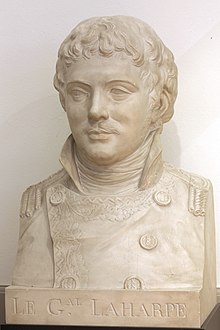Amédée Emmanuel François Laharpe
Amédée Emmanuel François Laharpe | |
|---|---|
 Bust of Laharpe in the Vaud Military Museum | |
| Birth name | Amédée Emmanuel François de la Harpe |
| Born | 27 September 1754 Rolle, Swiss Confederacy |
| Died | 8 May 1796 (aged 41) Codogno, Duchy of Milan |
| Allegiance | |
| Service/ | Infantry |
| Years of service | 1791–1796 |
| Rank | General of Division |
| Battles/wars | French Revolutionary Wars |
| Relations | Frédéric-César de la Harpe (cousin) |
Amédée Emmanuel François Laharpe (born de la Harpe, 27 September 1754 – 8 May 1796) was a Swiss military officer. He fought as a volunteer in the French Army during the French Revolutionary Wars, and led a division in Italy under Napoleon Bonaparte until his death in battle after being hit by friendly fire. He was a cousin of the Swiss political leader Frédéric-César de la Harpe.
Early career[]
Amédée de la Harpe was born on 27 September 1754 as the son of Louis Philippe de la Harpe and Sophie Hugonin, in Rolle, Switzerland.[1] He attended school in Haldenstein along with his cousin Frédéric-César de la Harpe,[1] who would become the main leader of the successful movement for the liberation of Vaud from the rule of the canton of Bern.[2]
As a young man La Harpe served as a mercenary in the Netherlands.[1] After returning home he commanded a Vaud militia company, and between 1780 and 1791 sat at the Council of Two Hundred of Lausanne.[1] When the French Revolution broke out in 1789, he renounced his seigneurial privileges. On 15 July 1791, La Harpe held a banquet in Rolle to celebrate the two-year anniversary of the Storming of the Bastille.[1] The authorities in Bern condemned this pro-revolution movement, causing La Harpe to flee to France as others involved were already being arrested and imprisoned in Chillon Castle. He was then sentenced to death in absentia, and his property in Switzerland was confiscated.[3]
In 1792, in accordance with the laws of revolutionary France and his own beliefs, La Harpe dropped the nobiliary particle "de" from his surname and changed it to Laharpe.[4]
Revolutionary Wars[]
Laharpe joined the French army in late 1791 as a lieutenant-colonel "en seconde" of the 4th volunteer batallion of Seine-et-Oise,[5] first being deployed with the Army of the Rhine and then the Army of the Alps.[3] He was promoted to lieutenant-colonel of the 35th Infantry Regiment in January 1793[5] and distinguished himself at the Siege of Toulon, being rewarded with the rank of brigade general in December of that year.[5] This rank was confirmed when Laharpe was assigned to the Army of Italy in August 1794, and fought the following month at the First Battle of Dego.[5]
His promotion to general of division came in August 1795,[5] and later in the year Laharpe took part in the Battle of Loano.[3] When Napoleon Bonaparte took command of the Army of Italy in March 1796, his division commanders included Laharpe, André Masséna, Pierre Augereau, and Jean Sérurier. In the Montenotte Campaign, these four divisions rapidly defeated the Austrian army and forced the Kingdom of Sardinia-Piedmont to sue for peace. Laharpe fought at the battles of Montenotte and, once again, at Dego.[3] Thereafter, his troops guarded the east flank of the army against a possible Austrian counterattack.
With the Sardinians subdued, Bonaparte moved against Johann Beaulieu's Austrian army. After marching along the south bank of the Po River, Laharpe's division crossed near Piacenza and thrust north to turn Beaulieu's left flank. Laharpe, with his own division and the army's advance guard, defeated Anton Lipthay's Austrians at the Battle of Fombio during the day on 8 May. After this action, the French pursued as far as Codogno, and that evening another Austrian unit blundered into the French units in the area. Amid a night of confused clashes and low visibility, Laharpe was accidentally shot dead by his own troops as he returned to camp after a reconnaissance.[6]
While exiled in Saint Helena, Napoleon wrote of Laharpe as "an officer of distinguished bravery. A grenadier in heart and stature. Beloved by his troops whom he led with intelligence".[7] He is honored on the Arc de Triomphe in Paris, where the name LAHARPE is inscribed on column 24, right below that of fellow Vaudois volunteer Reynier.
References[]
- ^ Jump up to: a b c d e Abetel-Béguelin, Fabienne. "La Harpe, Amédée de". Historical Dictionary of Switzerland (in French). Retrieved 18 April 2021.
- ^ Herold, J. Christopher (21 October 2016). The Swiss Without Halos. Pickle Partners Publishing. ISBN 9781787201385.
- ^ Jump up to: a b c d Secretan, Eugène (1898). "Le général Amédée de la Harpe". Revue Militaire Suisse (in French).
- ^ Chateauneuf, A. (1807). Le nepos français (in French). 11. Paris. p. 132.
- ^ Jump up to: a b c d e Chavaray, Jacques (1893). Les généraux morts pour la patrie: 1792-1871 (in French). Paris. p. 34.
- ^ Chandler, p 80
- ^ Fiebeger, G. J. (1911). The Campaigns of Napoleon Bonaparte of 1796–1797. West Point, New York: US Military Academy Printing Office. p. 17.
- Chandler, David. The Campaigns of Napoleon. New York: Macmillan, 1966.
| Wikimedia Commons has media related to Amédée Emmanuel François Laharpe. |
- 1754 births
- 1796 deaths
- French generals
- French Republican military leaders killed in the French Revolutionary Wars
- People from Rolle
- Military personnel killed by friendly fire
- Swiss military personnel of the Napoleonic Wars
- Names inscribed under the Arc de Triomphe
- Swiss nobility
- People sentenced to death in absentia